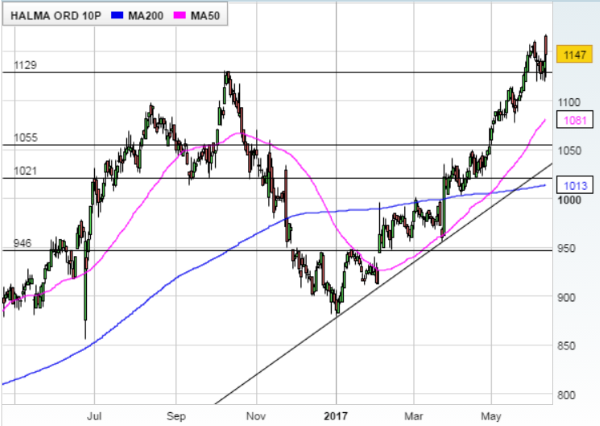Halma: Records keep tumbling at this star share
13th June 2017 13:01
by Lee Wild from interactive investor
Share on
When publishes financial results, dividends get broken. It's been the case for as long as I've covered them, and this time is no different - record revenue and record profit for a 14th consecutive year, and a further inflation-beating dividend increase. The share price is at a record high, too, but the valuation multiple is an issue for some.
Include acquisitions and a 10% currency boost, and the maker of smoke detectors and automatic door sensors increased pre-tax profit by 17% to £194 million in the 52 weeks to 1 April, on revenue up 19% at £962 million. Organic profit growth was 3.6% to £172 million on revenue up 4.3% at £842 million.
This is all in line with market expectations. However, there was an extra trading week last year, so on a like-for-like basis organic growth was over 5%.
Three of the four divisions - Infrastructure Safety, Medical and Environmental & Analysis - reported organic growth at both the top and bottom line. Process Safety generated record sales, although profit dipped 4.3%. However, even here, profit did grow in the second half, and the division is now less reliant on weaker energy and resources markets.
Halma's broad spread of businesses is a plus, too, with 9% organic sales growth in Asia Pacific, 11% in China, 6% in mainland Europe, 7% in the UK and 1% in the huge US market.
Group profit margin was down 40 basis points at 20.2%, but still well within the company's target range of 18-22%. And, while the dividend yield is modest at around 1.4%, it is ultra-reliable. A 7% increase in the final payout guaranteed a 38th consecutive year of dividend per share increases of 5% or more.
And this has gone down well with investors; Halma shares traded as high as 1,168p Tuesday, their best ever.

However, that does put them on a forward price/earnings (PE) ratio of 27.2. UBS forecasts adjusted earnings per share (EPS) of 42.9p in the year to March 2018, up from 40.2p this time and 34.3p a year ago.
This morning, I asked chief executive Andrew Williams whether it was becoming an increasingly hard sell to major shareholders and potential investors. It seems not.
"It's about us communicating to them how it all works, about our competitive strengths, our ability to acquire easily, combine businesses and also sell them.
"We have an ability to get out of non-growth markets into growth markets quickly. It's about execution, innovation, management talent and also knowing when the time is right to get out or get in that underpins strength longer term."
He also talked about beefing up Halma's digital strategies in each division, and has created a new role to oversee it. Next month, Inken Braunschmidt joins Halma from a German renewables energy company to fill the position of chief innovation officer.
Of course, directors would talk up their own business, wouldn't they, but Halma is favoured for precisely the reasons set out by Williams. Goldman Sachs says it's "one of the highest quality stocks in our coverage".
Yes, the shares do look expensive, and Goldman admits the current rating is a bit rich for it - a multiple of 18 times enterprise value/operating profit for calendar-year (CY) 2018 is a 30% premium to European peers. But investors have been saying that for years.
Investec Securities analysts Michael Blogg and Chris Dyett are bullish.
"As usual, we value the shares at a 40% premium to the sector – excluding Halma itself and , which is on an earnings recovery tack – to reflect its record and its very high gross margins (over 60%).
"Rolling the reference period forward by one year, to CY17-CY19, our valuation rises by 18% [from 1,085p] to 1,280p and we reiterate 'buy'."
In late 2016, Halma suffered a blip when recent acquisitions Firetrace and CenTrak caused first-half results to miss expectations. The shares fell sharply, but analysts at Numis Securities summed up the general attitude to Halma.
"We continue to believe Halma is uniquely well positioned to deliver long term earnings growth in the low/mid-teens and would be buyers on any weakness," they said. Investors did, and the shares are up over 30% since.
It's this visibility on earnings that makes them popular, and order intake since year end, we're told, continues to be ahead of both revenue and order intake last year.
Some still need convincing, though. Mark Fielding, an analyst at UBS, has never been a fan, and downgraded his rating from 'neutral' to 'sell' last month, with price target of 785p.
"Our 'sell' rating reflects a high valuation," he said Tuesday, but he also has concerns that organic growth rates may be slightly lower than history, and that acquired growth may not meet targets following just one acquisition in the last financial year.
This article is for information and discussion purposes only and does not form a recommendation to invest or otherwise. The value of an investment may fall. The investments referred to in this article may not be suitable for all investors, and if in doubt, an investor should seek advice from a qualified investment adviser.